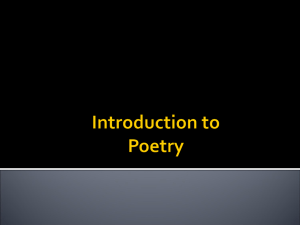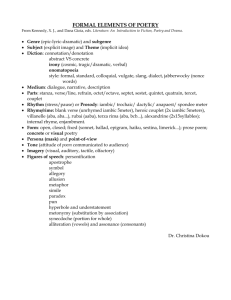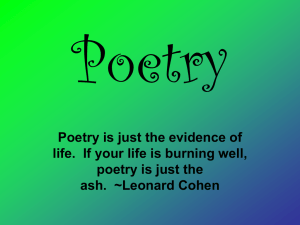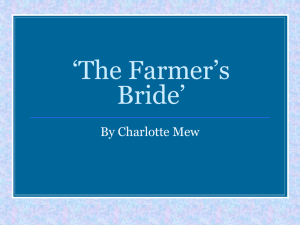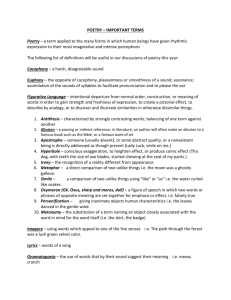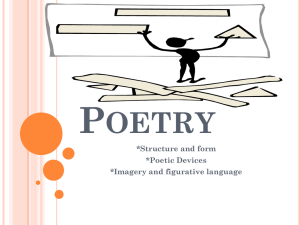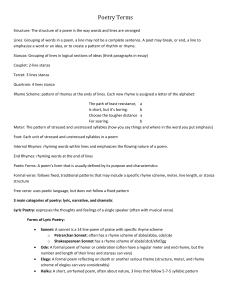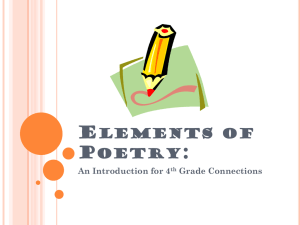High Level MAP Cards – FINAL
advertisement
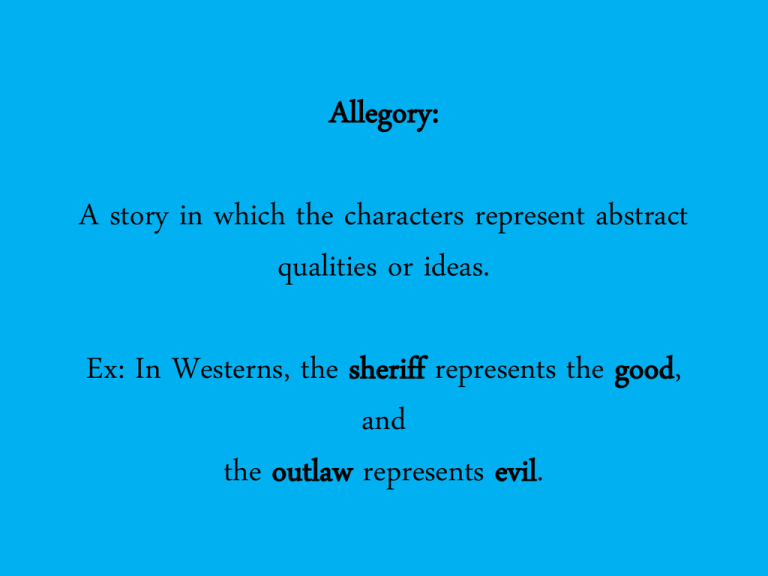
Allegory: A story in which the characters represent abstract qualities or ideas. Ex: In Westerns, the sheriff represents the good, and the outlaw represents evil. Anecdote: A short, humorous story about a real incident or person. Ex: In his first year as president, Barrack Obama had a prank pulled on him. He is afraid of spiders and his wife put a tarantula in his office. Myth: A legend that embodies the beliefs of people and offers some explanation for natural and social phenomena. Ex: In Greek Mythology, Zeus is the God of the sky and is the cause of thunder and lightning. Parable: A short story that uses familiar events to show an ethical point. Ex: A man was beaten and left on the side of a road. People kept passing by without helping. In the end, his enemy was the one to stop and help. The ethical point in this story is to always help others, even if it is not easy. Parody: A humorous, exaggerated imitation of another work. Prose: Writing organized into sentences and paragraphs. In other words, normal writing— not poetry. Satire: A work that makes fun of something or someone. Ex: “Family Guy” or “The Simpsons” Cliché: Overused stereotyped expression. Ex: “What goes around comes around.” Imagery: Vivid description that helps the reader imagine how something looks, sounds, feels, smells, or taste. Most of the time, it refers to appearance. Ex: “The young bird’s white, feathered wings fluttered as he made his way across the night time sky.” Irony: Humor based on using words that suggest the opposite of the literal meaning; sarcasm. Ex: A man said to his boss, “Sir, may I say you are as smart as Einstein ever was.” Oxymoron: A phrase that contradicts itself. Ex: jumbo shrimp, frozen hot chocolate, or the living dead Paradox: A seeming contradiction. Ex: “It was the best of times. It was the worst of times.” or “I always lie.” Pathetic Fallacy: The attribution of human emotions or characteristics to inanimate objects or to nature. Ex: Angry sea or Cruel wind Bandwagon: A cause that attracts many people. Ex: When the Chicago Blackhawks won the Stanley Cup in 2010, a lot of people “jumped on the bandwagon” and became fans because they were doing so well. Bias: An inclination that usually is unfair and shows impartial judgment. Ex: When the woman voted for the best dancer, she was biased because she voted for her own daughter. Cynical Tone: - Believing or showing the belief that people are motivated only by selfish concerns; skeptical. - Tone is negative or pessimistic. Ex: “Don’t talk to me about voting. I’m not interested. All politicians are selfish and corrupt.” Flag Waving: An appeal intended to provoke patriotic emotions. Ex: During the opening ceremonies of the Olympics, the national anthem will be played in order to excite fans and get them fired up for their country to win. Flashback: A technique in which the author references an earlier event or scene. Ex: Hunger Games excerpt: “I look at Peeta and he gives me a sad smile. I hear Haymitch’s voice. ‘You could do a lot worse.’” Foreshadowing: A technique in which an author gives clues about something that will happen later in the story. Ex: He didn’t know what was in store for him, but would soon find out the truth. He felt a cold chill as he walked through the dark alley. Plain folks: An advertisement or piece of literature that features arguments in which a person represents themself as a commoner. Ex: In “Robin Hood”, Robin Hood is an example of a plain folk because he disguises himself as a commoner and steals from the rich to give to the poor. Propaganda: A form of communication that is aimed at influencing the attitude of a community toward some cause or position so as to benefit ones self or ones group. Ex: The famous “Uncle Sam” poster says “I want YOU for the U.S. Army!” Reflexive Tone: Writing that focuses on a belief or idea about life that is important to the writer. (Usually found in autobiographies and memoirs.) Ex: “I really learned that summer how life is short and I shouldn’t spend it worrying about other people’s problem.” Subplot: A line of action secondary to the main story. Ex: In The Hunger Games, the focus on Katniss and Gale hunting would be considered a subplot. Voice: The author’s style (the quality that makes his or her writing unique) conveys his or her attitude, personality or character. Ex: When voice is used in writing it displays the author’s personality, view point, age, and gender. Dramatic Monologue: A speech in which the narrator addresses a character who never actually appears in the story. Ex: Mom, mom where are you? (Sees something, starts shaking his head in denial.) No, no, no this isn’t happening. So you see, I’ve been waiting here because my mom and I are going to New York together. I’m not sure where my mom is, but I’m sure she’ll be here soon. Monologue: A long speech by one character in a play or story. Ex: “You guys might not know this, but I consider myself a bit of a loner. I tend to think of myself as a one-man wolf pack. But when my sister brought Doug home, I knew he was one of my own. And my wolf pack, it grew by one. So - there were two of us in the wolf pack.” Soliloquy: A monologue in which a character expresses his or her thoughts to the audience and does not intend the other characters to hear them. Ex: To be, or not to be--that is the question: Whether 'tis nobler in the mind to suffer The slings and arrows of outrageous fortune Or to take arms against a sea of troubles And by opposing end them Theater Essentials: A script for a play has directions about the lighting, movements and emotions for the actors to follow. Ex: In “A Christmas Carol” there are theater essentials to help the reader visualize the play. Allusion: A reference to something or someone, often literary. Ex: If you were trying to instill confidence in a friend and said, “Use the force,” that would be an allusion to “Star Wars.” Analogy: A relationship between two objects/ideas that is not immediately obvious. Ex: Car is to Street as Boat is to Lake (The car and boat are both vehicles, but a car is driven on a street and a boat is driven on a lake.) Also can be shown as: Car : Street as Boat : Lake Antithesis: The direct contrast or opposite of something. Ex: hope is the antithesis to despair Aphorism: A statement of truth or opinion that is short and to the point. AKA: a saying, maxim, adage, or cliché Ex: “Absence makes the heart grow fonder.” Archetype: The original model from which all things of the same kind are copied or based off of. Ex: Frankenstein or Dracula are archetypes that have influenced all subsequent horror stories. Assertion: Something declared or stated positively, often with no support or attempt at proof. Ex: “It will all be okay in the end.” Colloquialism: Language that is only appropriate for casual or informal conversation; slang. Ex: In the Midwestern states, soft drinks or soda is referred to as “pop”. Connotation: The emotional or cultural meaning attached to a word. Ex: The actual meaning of the word “snake” is “a limbless reptile that lives in various climates.” However, the connotation of “snake” can be a person who is sly and ruthless. Denotation: The dictionary definition/meaning or the literal meaning of a word. Ex: The denotation of the word “cheap” is “inexpensive”, but cheap can have a connotation that means “a person who does not like to spend money”. Iconoclast: A character that attacks cherished beliefs; a radical. Ex: Protestors who carry signs that are meant to defame the president. Motif: A theme or pattern that recurs in a work. Ex: In “Wizard of Oz” Dorothy leaves home and learns about herself. The theme of “going on a journey and learning about yourself” continues with the other characters. Pun: The use of a word in a way that plays on its different meanings. Ex: Noticing the bunch of bananas, the hungry gorilla went ape. Parallelism: When a writer or speaker expresses ideas of equal worth with the same grammatical form. Ex: “Veni, vedi, vici.” – Julius Caesar (Translation: I came, I saw, I conquered.) Red Herring: Something intended to divert attention from the real problem or matter at hand; a misleading clue. EX: You might find a red herring used in politics to avoid an issue or in mysteries when a murder suspect may use a red herring to divert suspicion away from them. Rhetorical Question: A question not meant to be answered. Ex: “Why can’t we just get along?” Synecdoche: A figure of speech where a part represents the whole. Ex: The “ABCs” are a synecdoche for the “alphabet”. Testimony: A formal statement that is written or spoken. Ex: When a person is interviewed for their side of a story it is their testimony. Validity: The soundness and justness of an argument. Word Play: A witty or clever verbal exchange Ex: Catchphase, Apples to Apples, Outburst all use word play in their games. Assonance: The repetition of vowel sounds. Ex: “Days wane away.” Blank verse: Unrhymed lines of poetry usually in iambic pentameter. Cinquain: A stanza with 5 lines Ex: Bunny Quiet, Furry Munching, Sniffing, Hopping Asleep in the clover Rabbit Consonance: The repetition of internal or ending consonant sounds of words close together in poetry. Ex: I dropped the locket in the thick mud next to the bricks. Couplet: - A pair of rhyming lines in a poem often set off from the rest of the poem. - Shakespeare’s sonnets all end in couplets. Ex: Blessed are you whose worthiness gives scope Being had, to triumph; being lacked, to hope Dirge: A poem reflecting on something you miss. Ex: You may write a dirge about an old friend or a lost pet. Elegy: A poem mourning the dead. (A EULOGY is a speech given at a funeral in honor of a person who has passed away – these are two different things.) End rhyme: Rhyming words that are at the ends of their respective lines—what we typically think of as normal rhyme. Ex: I live in a house by the sea That is where I like to be Epic: A long poem narrating the adventures of a heroic figure. Ex: In Homer’s The Odyssey, Odysseus makes a ten year voyage home after the Trojan War. Free Verse: Poetry with no set meter (rhythm) or rhyme scheme. Ex: Fog by Carl Sandburg The fog comes on little cat feet. It sits looking over harbor and city on silent haunches and then moves on. Iamb: A metrical foot consisting of an unstressed syllable followed by a stressed syllable. Ex : Come LIVE with ME and BE my LOVE. There are 8 iambs in the example. Iambic pentameter: Ten-syllable lines in which every other syllable is stressed. Ex: “With EYES like STARS upON the BRAVE night AIR.” (da-DUM- da-DUM- da-DUM- da-DUM- da-DUM) Internal rhyme: A rhyme that occurs within one line. Ex: “He’s king of the swing.” Limerick: -A form of humorous verse - The 1st, 2nd, and 5th lines rhyme with each other and have 7-10 syllables. -The 3rd and 4th lines rhyme with each other and have 5-7 syllables -Often starts with “There once was a …” Ex: There once was a man from Peru Who dreamed of eating his shoe, He awoke with a fright, In the middle of the night, And found that his dream had come true! Lyric: A type of emotional, songlike poetry. Meter: The pattern of stressed and unstressed syllables in the lines of a poem. Ex: Shall I comPARE thee TO a SUMmer’s DAY? Quatrain: A four-line stanza. From “Romeo and Juliet” by Shakespeare “Thus, from my lips by thine my sin is purged” “Then have my lips the sin that they have took” “Sin from my lips? O trespass sweetly urged;” “Give me my sin again.” “You kiss by the book” Rhyme Scheme: The pattern made by placing words which end in similar sounds at the ends of lines. Ex: Being able to rhyme in the knick of time. Is the best To pass the test. This rhyme scheme is AABB Rhythm: The arrangement of stressed and unstressed syllables into a pattern. Ex: “The Song of Hiawatha” by Longfellow By the shore of Gitchie Gumee, By the shining Big-Sea-Water, At the doorway of his wigwam, In the pleasant Summer morning, Hiawatha stood and waited. Scansion: The act of dividing lines of poetry into feet and meter. Ex: / ^ / ^ / ^ / ^ Double, double toil and trouble Sestina: Six stanzas with six-lines each. Then a three line ending (called an envoi). The end words of the first stanza are repeated in varied order (see below) as end words in the other stanzas. Ex: ABCDEF, FAEBDC, CFDABE, ECBFAD, DEACFB, BDFECA KEY Types of Stories - Blue Figurative Language - Yellow Writing Techniques – Pink Theater/Drama – Green Literary Terms - Orange Poetry - White Sonnet: A fourteen-line poem written in iambic pentameter. Different kinds of sonnets have different rhyme schemes. Ex: Shakespeare Sonnet #18 Shall I compare thee to a Summer's day? Thou art more lovely and more temperate: Rough winds do shake the darling buds of May, And Summer's lease hath all too short a date: Sometime too hot the eye of heaven shines, And oft' is his gold complexion dimm'd; And every fair from fair sometime declines, By chance or nature's changing course untrimm'd: But thy eternal Summer shall not fade Nor lose possession of that fair thou owest; Nor shall Death brag thou wanderest in his shade, When in eternal lines to time thou growest: So long as men can breathe, or eyes can see, So long lives this, and this gives life to thee.
